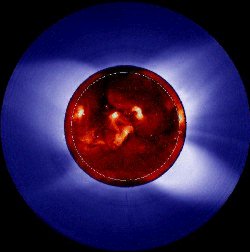This image shows wind speeds and directions over a segment of the ocean. The red color denotes faster wind speeds while the blue color denotes slower wind speeds. Scientists once wondered if changes in the Sun affected wind patterns on Earth.
Click on image for full size
Courtesy of U.S. Navy/NRL/NOAA
Sun's Effect on Earth's Weather (Wind)
The
Sun affects many things
on Earth. One of the main things the Sun does is warm our planet, including
the atmosphere. This energy drives much of Earth's
weather.
The solar cycle is the rise and fall of the number of sunspots on the Sun. Sometimes there are lots of sunspots and sometimes there are few sunspots.
Scientists know that solar activity (like coronal mass ejections) is higher when there are more sunspots. Last century, scientists started to ask how the solar cycle might affect Earth's weather.
Scientists tried, but were not able to find correlations between the solar cycle and the Earth's weather.
One example was a study by Willet in 1949 to see if the solar cycle affected wind patterns on Earth. He saw the solar cycle as a definite factor in affecting wind variations. However, attempts to confirm his conclusions were not successful.
Over time, with more and more studies and better instruments (especially space satellites), connections between the solar cycle and Earth's weather have been found to be unlikely.
In fact, through much study by scientists around the world, Sun-weather connections have largely been rejected by the science community.
You might also be interested in:

Have you ever seen an explosion before? Maybe you've seen a volcano explode on t.v. Or maybe you've seen a potato explode in the microwave because your mom forgot to poke holes in it. Well, explosions
...more
When scientists do an experiment, they looking to see if two variables are related. A variable is something that changes. Sometimes variables are related (or correlated) in a positive way. That is, as
...more
The Sun is not a quiet place, but one that exhibits sudden releases of energy. One of the most frequently observed events are solar flares: sudden, localized, transient increases in brightness that occur
...more
Space weather is a new science. It hasn't been studied for thousands of years. So space weather has many questions that still need to be answered. And it has a lot of unsolved mysteries which is exciting!
...more
The Sun acts like it has a big magnet in the middle of it. We call this the Sun's magnetic field. The Sun's magnetic field has a fancier name, the Interplanetary Magnetic Field (IMF). This just means that
...more
The visible solar atmosphere consists of three regions: the photosphere, the chromosphere, and the solar corona. Most of the visible (white) light comes from the photosphere, this is the part of the Sun
...more
To understand how our Sun works, it helps to imagine that the inside of the Sun is made up of different layers, one inside the other. The center of the Sun is called the core. It is the region where the
...more
Scientists at the High Altitude Observatory (HAO) try to learn about the changes we see in the Sun over time. They also study how it affects the atmosphere of the Earth. There are four main areas of study
...more















